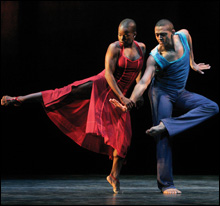
REMINISCIN’: Familiar Ailey characters at their local bar.
|
The Alvin Ailey American Dance Theater, now nearing its golden anniversary, is like a car company that’s developed such a perfect product, there’s no way to make a better one. You can keep tweaking the model to encourage sales, but there’s very little difference from year to year. The Bank of America Celebrity Series’s annual Ailey week at the Wang Theatre featured the vintage Revelations on all but one of the seven programs, plus a couple more Ailey dances, a new piece by artistic director Judith Jamison, and contributions by 10 other choreographers. What this repertory represents is an unbeatable mix of glamorous production values and dynamic dancing burnished with a lightly applied respect for spirituality and high art. Four new-to-Boston works on Wednesday night shared these qualities. Elements of early Ailey are getting woven into newer dances, as recognizable allusions to previous performances or tropes that carry predefined emotional content. This is a characteristic of classical repertory, not a failure of imagination. It’s like the repercussions of Sleeping Beauty that show up in Balanchine.
Ronald K. Brown’s Ife/My Heart (2005) was a rather diffuse gathering of people in traditional and contemporary clothes doing a blend of African and modern dance movement to a score of Afro-jazz drumming selections with Nikki Giovanni’s soulful poetry fading in and out. The audience didn’t get any clues about how the people in the African robes and turbans were related to the ones in quasi-1920s dresses and sports clothes, or why they all appeared in modern clothes at the end.
There were times when I thought certain individuals in one quartet were challenging certain others and being faced down, but the roles kept changing within the group. A woman jittered and poked her booty out like Josephine Baker. Another woman danced in the center of a circle like some sort of goddess figure or shaman.
The movement process was clearer, I thought, as Brown fused the rhythmic propulsiveness of an African beat with the gestural and sculptural possibilities of modern dance. There were tribal lines and circle dances, and eventually everyone who’d been part of a smaller unit was incorporated into the celebrating group. From the first moments, I thought of Ife/My Heart as an updated Revelations, without the gospel specificity but with more of a connection to the diasporic past.
Acceptance in Surrender, choreographed in 2005 by company members Hope Boykin, Abdur-Rahim Jackson, and Matthew Rushing, with dramatic color and smoke effects by lighting designer Al Crawford, had a uniform chorus of three men hovering protectively over an anguished Renee Robinson. Their enveloping arm gestures, off-center balances, and quick changes of focus evoked long-time company member Dudley Williams, who’s now retired.
Dutch choreographer Hans van Manen’s 1997 Solo, to two unaccompanied violin pieces by Bach, wasn’t a solo but an ironic comment on the frenetic virtuosity of the music. As if no one dancer could sustain Bach’s seven minutes of perpetual motion, Clifton Brown, Glenn Allen Sims, and Matthew Rushing spelled one another in relays of dizzying spins, leaps, fussy footwork, and cute gestures.